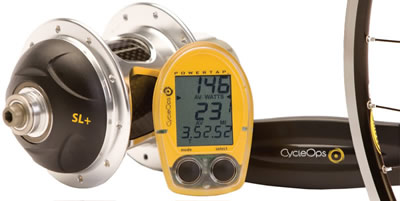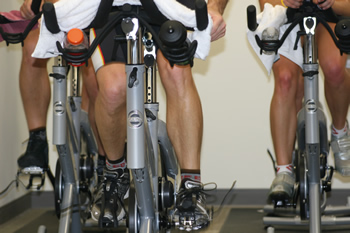FUNCTIONAL THRESHOLD POWER: IT COULD CHANGE THE WAY YOU TRAIN
Jarrett Pflieger
 Training with power on the bike is the best way to get an accurate gauge of your intensity level during workouts. Once you know how much power you can produce at certain training intensities, you will be able to do workouts that improve different aspects of your cycling ability, namely weakness, and make sure you stay in those zones during training.
Training with power on the bike is the best way to get an accurate gauge of your intensity level during workouts. Once you know how much power you can produce at certain training intensities, you will be able to do workouts that improve different aspects of your cycling ability, namely weakness, and make sure you stay in those zones during training.
The days of training by feeling alone are over if you want to truly do well at triathlon or in road racing. Even pure heart rate training can be misleading, as your heart rate is highly volatile and can change from day to day. If your heart rate is always changing, it is nearly impossible to know if you are training at the proper intensity levels depending on your goals. For instance, if you are a very good sprinter with strong legs, but you tend to get dropped on longer rides, you should probably incorporate longer endurance and base building sessions into your training schedule, but how do you know how hard to go in order to get the proper adaptation from your body?
In order to properly identify your bodies training zones, you should know your functional threshold power. Functional threshold power (FTP) is define as the maximum amount of average power you can sustain on the bike without extreme fatigue for one hour. Once you know your FTP, you can use it as a reference point to determine how much intensity you need over different distances for maximum physiological response depending on your goal for the workout.
To test your FTP, the first thing you need is a power measuring cycle. There are power taps you can buy for your own bike, or you can find a power measuring indoor trainer or even find a gym that has power measuring indoor cycles. To find the maximum power you could sustain over an hour, the obvious way would be to ride a 60-minute time-trial and measure your average power for that ride. Although this theoretically would be the most accurate way to measure your FTP, it is very hard for a rider to focus and be able to give everything they have for a full 60 minutes. Luckily there is a pretty accurate and much less time consuming way to test your functional threshold power.
To test your FTP, what you can do is perform a 20-minute time, record your average power for the session, then substract 5% to get an accurate estimate about what you could sustain over an hour. For example, if you averaged 300 watts for 20 minutes, multiply that by .95 to get your FTP, which would be 285.
One you know your FTP, you can use it as a reference point and increase or decrease intensity for workouts depending on how long you are riding and what you aim to accomplish during the workout.
Breaking down your specific training zones is a bit more complicated, but do research, buy some books, or find a qualified triathlon or cycling coach to help. Training too easy won’t do much for you, neither will training too hard. Knowing your functional threshold power will help you determine where you need to be for maximum workout effectiveness.
PUNCHING YOUR TICKET (TO KONA)
Ron Saetermoe
 I’m writing this article Thursday afternoon. Jarrett and I leave for Tempe in the morning. I’m fortunate to have so many great friends and supporters wishing me well for my race on Sunday (Ironman Arizona).
I’m writing this article Thursday afternoon. Jarrett and I leave for Tempe in the morning. I’m fortunate to have so many great friends and supporters wishing me well for my race on Sunday (Ironman Arizona).
Most of them are encouraging me to try to “punch my ticket” to the world championships in Kona. While I really appreciate their support, this is highly unlikely. I’ve done two of these races before and know how hard the event is. You really have to give it a lot of respect. Heck, you’ve really got to give the people who attempt it a lot of respect. It’s hard!
I’m racing as a 54 year-old this year, which means I’m at the wrong end of my age group (50-54). Yes, that four to five years makes a HUGE difference when you reach the half-century mark! Sure, there are guys at 54 that qualify for Kona, but they’re otherworldly like the biggest stud in my age group, Joe Bonness.
No, I’m racing for me this year. I’m racing for redemption. I wasn’t happy with my time last year and had a bunch of excuses for not doing better. This year I’m healthy and trained up better so I’m hoping for better results.
The funny thing about Ironman though is no matter how much planning and work you do you still don’t know what kind of day you’re going to get. The weather is predicted to be a cool, no…. COLD! 45 degrees. Can’t wait to jump into that dirty Tempe Town Lake in the dark in 45 degrees. At least the water will feel warm. The rest of the day should be lower 70s until nightfall. Not a lot of wind either. Almost perfect racing conditions.
Another factor that has been coming into play in recent years are the number of qualifying slots allocated to the various races. We should start about 2,300 – 2,400 competitors Sunday, which is about the same number as last year. The problem is we’ve got 10% fewer Kona slots than last year.
You see, WTC (the owner of most Ironman races in North America) keeps adding races and stealing slots from the established races to give them to the new ones. So while we’ll have about 40 more guys in my division than last year we’ll have one less slot (four instead of five). As a result, it keeps getting harder to qualify.
No, I’m hoping next year will be my year. 1.1.10 I age-up to the 55 – 59 age bracket which means I’ll be the baby again. There are fewer Ironman slots but there are also fewer competitors. In addition, I’m getting stronger on the bike and my running legs off the bike are getting stronger too.
My tentative plans for 2010 are to do Ironman California 70.3 then to register for Ironman St. George in May. Then to do Ironman Arizona again in November. Theoretically, this will give me three chances to qualify (if you don’t count my lottery entry) but realistically two. You see, all the really big dogs come out for the 70.3 races to try to get their Kona slot so my chances to qualify at California are EXTREMELY slim.
It’s a dream of mine to qualify and go to Kona. I’ll let you know when I do!
Cheers!
FREE GROUP WORKOUTS (Week of November 16th)
All of our group workouts are free to all members and non-members, so come on out! Please RSVP if you will be attending by emailing Jarrett@triathica.com or calling 949.273.6223. You can just show up if you want, but we can’t guarantee there will be anyone there to train with you if we don’t get any RSVP’s.
We want everyone to enjoy our group workouts but we should clarify the intent. The intent of the group workouts is to “workout.” Yes, it includes a social element. Yes, your Triathica host is happy to give you tips. But please be aware that everyone there is attempting to get a workout in at his or her own pace. If we all go at the slowest person’s pace many people won’t be getting in a proper workout. We will attempt to pair you up with another athlete so you’re not left alone. We welcome all levels of athletes.
Week of November 16th
Group workouts canceled this week due to Triathica Academy filming and Ron’s Ironman Arizona race.
We will resume group workouts next week. Come and join us!
THE ART OF REST AND RECOVERY
To be the best endurance athlete you can be, you have to effectively manage all aspects of training and this includes recovery time. Recovery time is the process that will restore your bodies’ energy levels and repair the damage that you inflicted in your workout. The three components of adequate recovery are nutrition, rest and active recovery.
Daily nutrition habits dictate the health status of your body, plus the amount of training you can withstand and adapt to. What you eat and drink every day has a direct impact on your athletic potential. If you eat poorly on a daily basis, your athletic potential will be low. You can wear yourself out with bad nutrition even faster than with exercise.

Maintaining daily optimal health through a nutritious diet will do more to speed your recovery from workouts than any other factor. You should try to get a nutritious meal immediately following your workout; the best time to restore your glycogen levels is in the first 20 minuets after a workout. After a hard workout your immune system is also more vulnerable so getting a healthy dose of antioxidants can really be beneficial for a fast recovery.
Some helpful rules of thumb to follow when planning a post-workout meal:
1. Eliminate all processed foods. Get rid of the junk. Your calories should come from lean meats, seafood, fresh fruits, vegetables and nuts.
2. Avoid eating and drinking empty calories. Make sure everything you put in your mouth has a high nutrient density.
3. Tracking your calories can also help ensure that you are getting an adequate amount to sustain your workouts. Fatigue can lessen your appetite and a calorie deficit can lead to injury and illness. This is also a main cause of over training.
4. Taking a multi-vitamin, iron and calcium supplement as well as antioxidants such as vitamins E and C can also help.
Rest after a workout is key, getting the proper rest both physically and mentally can make all the difference come race day. Rest after training allows for the neurological system to process and integrate any new stimulus. Rest also stimulates the production of human growth hormone, which is vital for the building of new muscle and the restoration of any damage. 
1. Try to get eight hours of sleep per night.
2. Get into a routine of the same bedtime and wake time. Go to bed and rise at the same time every day of the week, even on the weekends.
3. If you have the time, take a 45-minute nap in the afternoon or after your workout.
4. A powerful tool can also be meditation or visualization; studies have shown that mentally rehearsing actions (such as a transition) can greatly improve performance.
5. Massage can also be a great tool and promote relaxation. It can also aid in good blood circulation.
Active recovery consists of very easy workouts and should be short and enjoyable. You do not want this time to be stressful mentally or physically.
1. These should be short and simple, no more than 20-40 minutes.
2. Include family and friends, make these workouts fun.
3. Be gentle on your body and enjoy the aspect of what your body can do instead of pushing as hard as you do in your regular workouts.
Through nutrition, rest and active recovery you can balance the elements of the adaptation process; stress, recovery, growth. With the balancing of the recovery process you will be preparing your mind and body to reach and build the next and higher level of fitness preparing you for your next great performance.
9-WEEK CYCLING TRANSFORMATION PACKAGE
 Are you ready to get serious about your training? Is cycling one of your weaknesses, or are you just ready to take your skills on the bike to another level?
Are you ready to get serious about your training? Is cycling one of your weaknesses, or are you just ready to take your skills on the bike to another level?
Triathica’s nine-week cycling transformation package starts December 1st and will include one initial power test and a follow-up test to see your improvement over nine weeks ($100 value), 18 spin class workouts with power measuring cycles ($360 value), our first cycling workout DVD Power Up! ($20 value), and access to Triathica’s USAT certified coaches for any general questions you may have. We know times are tough, so we are offering all this for only $190! It’s time to kick start your off-season training.
We are having a free training with power seminar on November 24th at 6:00 p.m., so come on out to learn the benefits of training with power and how you can incorporate it into your own training. This is a perfect transition into the nine-week package.
Let us transform you!
Space is limited so call or email today: 949.273.6223 or jarrett@triathica.com.



